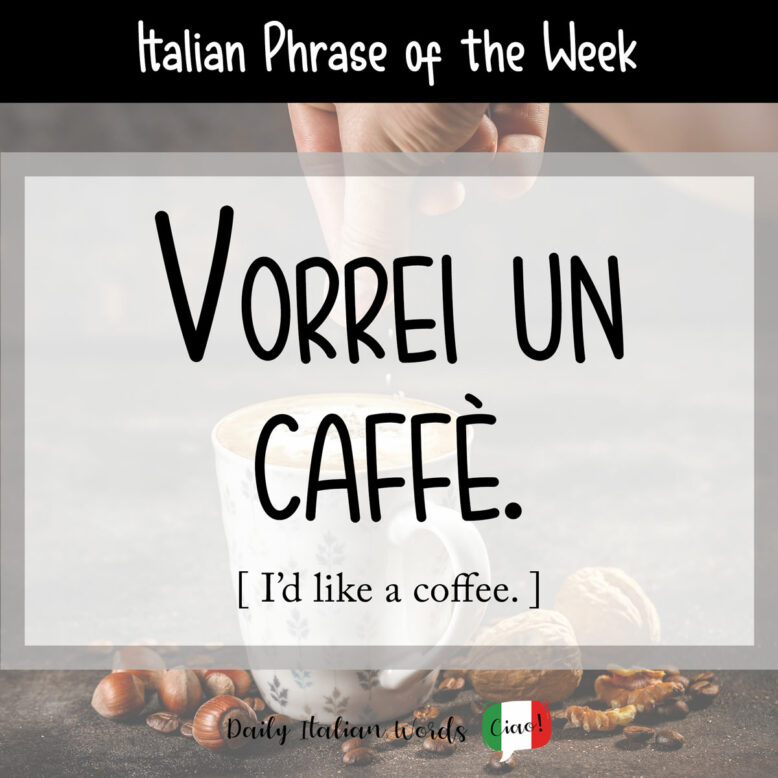If you visit a bar (café or coffee shop) in Italy, it is important to know how to order food and drink in Italian. In this article, we’ll be looking specifically at how to order a classic cup of coffee.
Vorrei un caffè.
I would like a coffee.

Let’s see how the phrase is composed.
Vorrei
Vorrei is the first-person present conditional of the Italian verb volere which means to want. (It literally translates as “I would want…“)
Italians use this verb form when making formal or polite requests, which is why it comes in handy when ordering food and drink. Here are a couple of additional examples:
– Vorrei una birra. = I’d like a beer.
– Vorrei una pizza margherita. = I’d like a margherita pizza.
un caffè
Caffè (coffee) is a masculine noun, so it is preceded by the masculine singular indefinite article un (a).

If all you ask for is a caffè, the waiter will most likely serve you the classic Italian espresso. If you want to drink a certain type of coffee, you need to be more specific. Here are the most popular types of coffee you’ll find in an Italian bar. The caffè word in brackets means you don’t have to state it explicitly.
- (caffè) espresso = coffee made with a small amount of nearly boiling water that is forced under pressure through finely-ground coffee beans. There is also the variable doppio which uses two shots of espresso.
- (caffè) ristretto: a more concentrated version made with a shorter shot of espresso and less water
- (caffè) macchiato = an espresso with froth
- cappuccino = an espresso with milk and froth
- marocchino = an espresso with chocolate and froth
- decaffeinato = decaffeinated coffee
Vorrei un caffè macchiato per favore.
I would like a macchiato please.

You can also ask for an americano which is a watered-down espresso, not to be confused with the caffè lungo which uses double the amount of water in comparison to an espresso to pull the shot.
Early in the morning or during the lunch break, bar are very busy with people bustling in and out to get their caffè shot before going back to work. Italians often drink it while standing at the counter, so that part of the café becomes very busy. You’ll often have to pay first at the cassa (check out) and then present the scontrino (receipt) to the barista, who’ll take five or six orders at the same time and either just look at the people in front of him, or use the following short phrases:
Some phrases the barista might use at the counter include:
- (che) Cosa prende? = lit: What are you taking?
- Mi dica. = lit: Tell me. (formal version)
- Per Lei? = For you? (Lei in this case is the formal version of you)
Customers will reply with just the essential words followed by a thank you, either while ordering the coffee or when being served.
- Un macchiato, grazie. = A macchiato, thanks.
- (Prendo) un cappuccino. = (I’ll take) a cappuccino.
- Per me un caffè doppio. = A double espresso for me.
Chi è il prossimo? Mi dica. – Un ristretto per me e un cappuccino per la signora, grazie.
Who’s next? Go ahead. – A ristretto for me and a cappuccino for the lady, thanks.
Whereas in English, we might specify that we want a cup of coffee, this extra bit of information is considered redundant in Italian, so you’ll rarely hear someone ask for una tazza di caffè (una tazza = a cup).
Heather Broster is a graduate with honours in linguistics from the University of Western Ontario. She is an aspiring polyglot, proficient in English and Italian, as well as Japanese, Welsh, and French to varying degrees of fluency. Originally from Toronto, Heather has resided in various countries, notably Italy for a period of six years. Her primary focus lies in the fields of language acquisition, education, and bilingual instruction.


